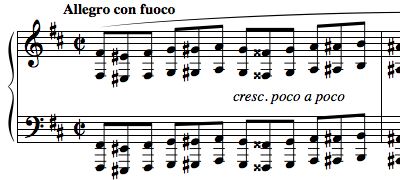
Étude Op. 25, No. 10 (Chopin)
Encyclopedia

B minor
B minor is a minor scale based on B, consisting of the pitches B, C, D, E, F, G, and A. The harmonic minor raises the A to A. Its key signature has two sharps .Its relative major is D major, and its parallel major is B major....
is a solo piano
Piano
The piano is a musical instrument played by means of a keyboard. It is one of the most popular instruments in the world. Widely used in classical and jazz music for solo performances, ensemble use, chamber music and accompaniment, the piano is also very popular as an aid to composing and rehearsal...
study
Étude
An étude , is an instrumental musical composition, most commonly of considerable difficulty, usually designed to provide practice material for perfecting a particular technical skill. The tradition of writing études emerged in the early 19th century with the rapidly growing popularity of the piano...
in B minor
B minor
B minor is a minor scale based on B, consisting of the pitches B, C, D, E, F, G, and A. The harmonic minor raises the A to A. Its key signature has two sharps .Its relative major is D major, and its parallel major is B major....
, composed by Frédéric Chopin
Frédéric Chopin
Frédéric François Chopin was a Polish composer and virtuoso pianist. He is considered one of the great masters of Romantic music and has been called "the poet of the piano"....
in 1835.
Structure
Étude Op. 25, No. 10 features many unique aspects not present in most Chopin's études, including a significant and distinctive ternary formTernary form
Ternary form, sometimes called song form, is a three-part musical form, usually schematicized as A-B-A. The first and third parts are musically identical, or very nearly so, while the second part in some way provides a contrast with them...
. The first theme
Theme (music)
In music, a theme is the material, usually a recognizable melody, upon which part or all of a composition is based.-Characteristics:A theme may be perceivable as a complete musical expression in itself, separate from the work in which it is found . In contrast to an idea or motif, a theme is...
is presented as a series of eighth note
Eighth note
thumb|180px|right|Figure 1. An eighth note with stem facing up, an eighth note with stem facing down, and an eighth rest.thumb|right|180px|Figure 2. Four eighth notes beamed together....
-tuplet
Tuplet
In music a tuplet is "any rhythm that involves dividing the beat into a different number of equal subdivisions from that usually permitted by the...
s in cut time, played at a very fast rate of Allegro. The second theme is in B minor
B minor
B minor is a minor scale based on B, consisting of the pitches B, C, D, E, F, G, and A. The harmonic minor raises the A to A. Its key signature has two sharps .Its relative major is D major, and its parallel major is B major....
's parallel major
Parallel key
In music, parallel keys are the major and minor scales that have the same tonic. A major and minor scale sharing the same tonic are said to be in a parallel relationship...
, B major
B major
In music theory, B major is a major scale based on B. The pitches B, C, D, E, F, G, and A are all part of the B major scale. Its key signature has five sharps....
, and in triple metre
Triple metre
Triple metre is a musical metre characterized by a primary division of 3 beats to the bar, usually indicated by 3 or 9 in the upper figure of the time signature, with 3/4, 3/2, and 3/8 being the most common examples...
. The second theme is repeated four times, and develops into a variation of the first theme, returning to cut time and B minor.
Copious pedal point
Pedal point
In tonal music, a pedal point is a sustained tone, typically in the bass, during which at least one foreign, i.e., dissonant harmony is sounded in the other parts. A pedal point sometimes functions as a "non-chord tone", placing it in the categories alongside suspensions, retardations, and passing...
notes and phrase
Phrase (music)
In music and music theory, phrase and phrasing are concepts and practices related to grouping consecutive melodic notes, both in their composition and performance...
markings are present in the second theme, but the entire étude lacks any pedal indications. Similar to the Op. 10, No. 4 étude
Étude Op. 10, No. 4 (Chopin)
Étude Op. 10, No. 4, in C-sharp minor, is a study for solo piano composed by Frédéric Chopin in 1830. It was first published in 1833 in France, Germany, and England as the fourth piece of his Études Op. 10...
, Chopin emphasizes legato
Legato
In musical notation the Italian word legato indicates that musical notes are played or sung smoothly and connected. That is, in transitioning from note to note, there should be no intervening silence...
playing through the phrasing and (lack of) pedal marking. Throughout the entire work, Chopin marks only five dynamic
Dynamics (music)
In music, dynamics normally refers to the volume of a sound or note, but can also refer to every aspect of the execution of a given piece, either stylistic or functional . The term is also applied to the written or printed musical notation used to indicate dynamics...
markings; the entire first theme is to be played forte to fortissimo, and the whole second theme is piano.

